Neurohumoral mechanisms - Study guides, Class notes & Summaries
Looking for the best study guides, study notes and summaries about Neurohumoral mechanisms? On this page you'll find 21 study documents about Neurohumoral mechanisms.
All 21 results
Sort by
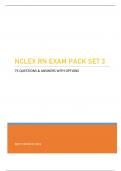
-
NCLEX RN EXAM PACK SET 3 LATEST UPDATE 2023
- Exam (elaborations) • 59 pages • 2023
-
- $19.99
- + learn more
BEST VERIFIED 2023 NCLEX RN EXAM PACK SET 3 75 QUESTIONS & ANSWERS WITH OPTIONS 1. 1. Question A patient with Parkinson’s disease has a nursing diagnosis of Impaired Physical Mobility related to neuromuscular impairment. You observe a nursing assistant performing all of these actions. For which action must you intervene? o A. The NA assists the patient to ambulate to the bathroom and back to bed. o B. The NA reminds the patient not to look at his feet when he is walking. o C. The NA ...

-
NCLEX RN EXAM PACK SET 3 LATEST UPDATE 2023
- Exam (elaborations) • 59 pages • 2023
-
- $17.99
- + learn more
BEST VERIFIED 2023 NCLEX RN EXAM PACK SET 3 75 QUESTIONS & ANSWERS WITH OPTIONS 1. 1. Question A patient with Parkinson’s disease has a nursing diagnosis of Impaired Physical Mobility related to neuromuscular impairment. You observe a nursing assistant performing all of these actions. For which action must you intervene? o A. The NA assists the patient to ambulate to the bathroom and back to bed. o B. The NA reminds the patient not to look at his feet when he is walking. o C. The NA ...
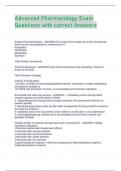
-
Advanced Pharmacology Exam Questions & Answers
- Exam (elaborations) • 42 pages • 2023
-
- $13.00
- + learn more
Advanced Pharmacology Exam Questions with correct Answers Explain Pharmacokinetics - ANSWER The study of how drugs are moved through the body and are encompassed in mechanisms of: Absorption Distribution Metabolism Excretion Think Kinetic (movement) Pharmacodynamics - ANSWER study of the biochemical and physiologic effects of drugs on the body Think Dynamic (change) majority of drugs either (a) mimic or inhibit normal physiological/biochemical processes or inhibit pathological processes in ...
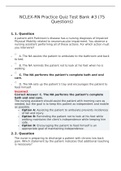
-
NCLEX-RN Practice Quiz Test Bank #3 (75 Questions)
- Exam (elaborations) • 64 pages • 2022
-
- $15.49
- + learn more
NCLEX-RN Practice Quiz Test Bank #3 (75 Questions) 1. 1. Question A patient with Parkinson’s disease has a nursing diagnosis of Impaired Physical Mobility related to neuromuscular impairment. You observe a nursing assistant performing all of these actions. For which action must you intervene? o A. The NA assists the patient to ambulate to the bathroom and back to bed. o B. The NA reminds the patient not to look at his feet when he is walking. o C. The NA performs the patient’s c...
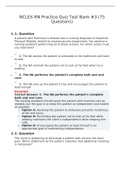
-
NCLEX-RN Practice Quiz Test Bank #3 (75 Questions)
- Exam (elaborations) • 64 pages • 2021
- Available in package deal
-
- $16.49
- + learn more
NCLEX-RN Practice Quiz Test Bank #3 (75 Questions) 1. 1. Question A patient with Parkinson’s disease has a nursing diagnosis of Impaired Physical Mobility related to neuromuscular impairment. You observe a nursing assistant performing all of these actions. For which action must you intervene? o A. The NA assists the patient to ambulate to the bathroom and back to bed. o B. The NA reminds the patient not to look at his feet when he is walking. o C. The NA performs the patient’s c...

-
NCLEX-RN Practice Quiz Test Bank #3 (75 Questions) 2022 UPDATE WITH RATIONALES
- Exam (elaborations) • 64 pages • 2021
- Available in package deal
-
- $15.99
- + learn more
NCLEX-RN Practice Quiz Test Bank #3 (75 Questions) 1. 1. Question A patient with Parkinson’s disease has a nursing diagnosis of Impaired Physical Mobility related to neuromuscular impairment. You observe a nursing assistant performing all of these actions. For which action must you intervene? o A. The NA assists the patient to ambulate to the bathroom and back to bed. o B. The NA reminds the patient not to look at his feet when he is walking. o C. The NA performs the patient’s c...
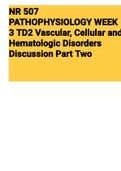
-
Exam (elaborations) NR 507 PATHOPHYSIOLOGY WEEK 3 TD2 Vascular, Cellular and Hematologic Disorders Discussion Part Two.pdf
- Exam (elaborations) • 23 pages • 2022
-
- $7.99
- + learn more
Exam (elaborations) NR 507 PATHOPHYSIOLOGY WEEK 3 TD2 Vascular, Cellular and Hematologic Disorders Discussion Part T This week's graded topics relate to the following Course Outcomes (COs). 1 Analyze pathophysiologic mechanisms associated with selected disease states. (PO 1) 2 Differentiate the epidemiology, etiology, developmental considerations, pathogenesis, and clinical and laboratory manifestations of specific disease processes. (PO 1) 3 Examine the way in which homeostatic, adap...
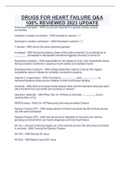
-
DRUGS FOR HEART FAILURE Q&A 100% REVIEWED 2023 UPDATE
- Exam (elaborations) • 6 pages • 2023
-
- $11.49
- + learn more
Ryanodine receptors - ANS-responsible for the release of Ca2+ from intracellular stores during excitation-contraction coupling in both cardiac and skeletal muscle Dihydropyridine receptors - ANS-voltage-dependent calcium channel that triggers intracellular calcium release for excitation-contraction coupling troponin C, tropomyosin - ANS-Ca binds to ___________ and ____________ is removed therefore removing the inhibition of actin and myosin binding contracts - ANS-Actin and myosin binds...
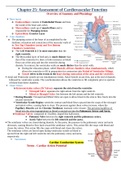
-
BIOL 2 Assessment of Cardiovascular Function MS2 | Download To Score A+
- Other • 20 pages • 2021
-
- $10.99
- + learn more
Chapter25 Assessment of Cardiovascular Function Overview of Anatomy and Physiology • Three layers o Endocardium: inside layers o Myocardium: made up of muscle fibers and is responsible for the pumping actions o Epicardium: outer layers o Fluids can be accumulate in these layers • Four chambers o 2 atria and 2 ventricles o Hemodynamic: the use of pressure monitoring devices to directly measure cardiovascular function • Heart valves • Chambers • Heart Valves o Atrioventricular valves o S...
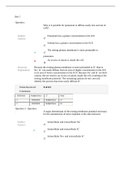
-
NSG 5003 Questions and Answers_Latest,100% CORRECT
- Exam (elaborations) • 42 pages • 2021
-
- $19.47
- + learn more
NSG 5003 Questions and Answers_Latest Quiz 1 Question : Why is it possible for potassium to diffuse easily into and out of cells? Student Answer: Potassium has a greater concentration in the ICF. Sodium has a greater concentration in the ECF. The resting plasma membrane is more permeable to potassium. An excess of anions is inside the cell. Instructor Explanation: Because the resting plasma membrane is more permeable to K+ than to Na+, K+ can easily diffuse from its area of higher concentration ...

How did he do that? By selling his study resources on Stuvia. Try it yourself! Discover all about earning on Stuvia


